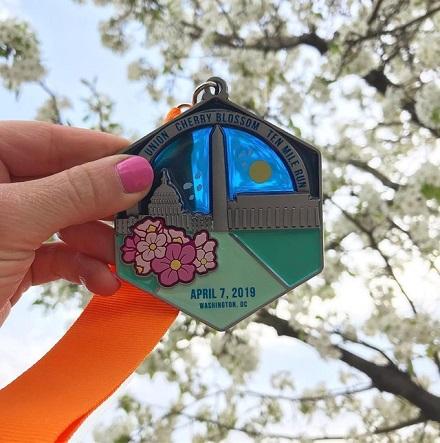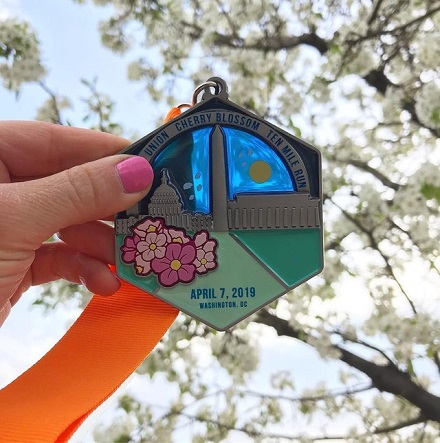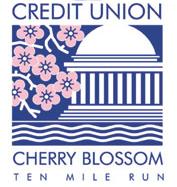
On the East Coast in April, the place to be, if you’re a runner and these are normal times, is The Credit Union Cherry Blossom Ten Mile and 5K Run/Walk, organized by Cherry Blossom, Inc., a 501c(3) chapter of the Road Runners Club of America. The race is known as "The Runner's Rite of Spring®" in the Nation's Capital. The staging area for the event is on the Washington Monument Grounds and the course passes in sight of all of the major Washington, DC Memorials. The event serves as a fundraiser for the Children's Miracle Network Hospitals, a consortium of 170 premier children's hospitals across North America. The race is in high demand, and entry is granted through a lottery system that opens to runners each December. The Credit Union Cherry Blossom Run is also part of the National Cherry Blossom Festival, "America's Greatest Springtime Celebration."
But COVID-19 has proven these are not normal times and it was because of that fact that the Credit Union Cherry Blossom Ten Mile, for the first time in its history, could not be held on schedule. Instead, organizers offered the first ever (and, they hope, the last ever) Cherry Blossom Virtual Run. SDM spoke with Phil Stewart, the race director, and found out about the encouraging response from runners.

Phil Stewart: Our thought process on it was that there were a lot of people who had put in a lot of time preparing, training and getting ready for the Cherry Blossom. When participation no longer was a possibility, we wanted to create something that was a close approximation. We wanted to provide them with that opportunity. Once we announced the cancellation, we found people still wanted to do something.
SDM: What kind of participation were you encouraging?
 Stewart: We wanted people to post pictures and make comments. As long as they completed the virtual race by 11:59 p.m. on April 5 and submitted their results to us, we said we’d publish those results on our site. We also encouraged social media posting and short videos.
Stewart: We wanted people to post pictures and make comments. As long as they completed the virtual race by 11:59 p.m. on April 5 and submitted their results to us, we said we’d publish those results on our site. We also encouraged social media posting and short videos.
SDM: How do you know they’ll run the full distance?
Stewart: Well, there’s a disclaimer. Unlike the real racecourse, the course they run will vary and so will the distance. What we were trying to do was capture the spirit, rather than the competitiveness, of race day.
SDM: Changing directions for a moment, did sponsors appreciate the new virtual format?
Stewart: We were able to get some of the sponsors to stay on, and we made sure there were virtual tie-ins to them. For example, one of our sponsors was Garmin and so of course, we challenged people to submit a photo of the time they ran by posting a photo of their Garmin watch.
SDM: The Cherry Blossom is one of the most desirable races to run and it sells out each year. Did you open the virtual race to everyone?
Stewart: No, it was only open to people who had registered to run in the actual race.
SDM: Was it free for them to participate?
 Stewart: Yes, it was free. We thought it was important to try and make some gesture toward the runners.
Stewart: Yes, it was free. We thought it was important to try and make some gesture toward the runners.
SDM: What is the typical field for the race, and how many participated in the virtual option?
Stewart: About 20,000 usually participate in both the 10 Mile and the 5K Run-Walk combined. About 2,200 participated, and those who did, really got into it.
Editor's note: Links regarding participation can be found here and here.
SDM: The event offered refunds to everyone who couldn’t participate, or it allowed them to use their race fee as a way of bypassing the registration lottery and guaranteeing entry in next year’s race; however, they would need to pay entry fees next year as well.
Stewart: We also gave people the option of donating their entry fee to the official race charity, Children's Miracle Network Hospitals. Since 2002, over $9.5 million has been raised on behalf of 170 Children's Miracle Network Hospitals, including $385,000 from last year's event. We would like to carry on the legacy of enabling Credit Union Miracle Day to make a sizeable contribution to Children's Miracle Network Hospitals, even though the annual tradition of the race itself will be interrupted this year.
SDM: The fact that the race is in such demand among runners is what makes it desirable for them to use this year’s race fee to bypass the registration lottery next year.
 Stewart: Being able to bypass the lottery was enough of a carrot for many runners but we realize this race is unique; a lot of them don’t have that carrot.
Stewart: Being able to bypass the lottery was enough of a carrot for many runners but we realize this race is unique; a lot of them don’t have that carrot.
SDM: Was it difficult for you to create a virtual event?
Stewart: We had to incur some programming costs in order to set it up.
SDM: Other race owners are being faced with the problem of what to do with cancelled events.
Stewart: When you cancel a race, you’re faced with economic ramifications. The situation facing each race owner is unique. The longer you have before race day, the better off you are; every day you get closer to an event, there’s less you can recoup.
SDM: What other changes did you have to make?
Stewart: We had contracts with hotels, but cancellation was covered by a force majeure clause, and that made a substantial difference to us. At the same time, we know there are a lot of hotel employees who are unemployed.
SDM: Overall, everyone wants to do the best they can in a bad situation. What kind of reception overall have you gotten for this event?
Stewart: The feedback we’ve been getting on social media has been favorable. People realize this is an unprecedented situation. What has helped us is that we’ve endeavored to be fair to people and to respond to them as quickly as we can.

 www.cherryblossom.org
www.cherryblossom.org